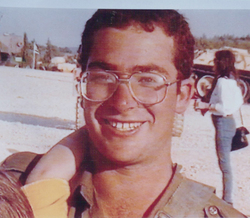
The 84th "Givati" Brigade is an Israel Defense Forces infantry brigade formed in 1947.
This page is a partial listing of incidents of violence in the Israeli-Palestinian conflict in 2004.

The Popular Resistance Committees is a coalition of a number of armed Palestinian groups opposed to what they regard as the conciliatory approach of the Palestinian Authority and Fatah towards Israel.

Gilad Shalit is a former MIA soldier of the Israel Defense Forces (IDF) who, on 25 June 2006, was captured by Palestinian militants in a cross-border raid via tunnels near the Israeli border. Hamas held him captive for over five years until his release on 18 October 2011 as part of a prisoner exchange deal.

The 2006 Gaza–Israel conflict, known in Israel as Operation Summer Rains, was a series of battles between Palestinian militants and the Israel Defense Forces (IDF) during summer 2006, prompted by the capture of Israeli soldier Gilad Shalit by Palestinian militants on 25 June 2006. Large-scale conventional warfare occurred in the Gaza Strip, starting on 28 June 2006, which was the first major ground operation in the Gaza Strip since Israel's unilateral disengagement plan was implemented between August and September 2005.
This is the Timeline of the Israeli–Palestinian conflict in 2007.
Events in the year 1994 in Israel.
Events in the year 1975 in Israel.
The 2010 Palestinian militancy campaign was a coordinated effort by 13 Palestinian militant groups, led by Islamist group Hamas, to derail peace talks between Israel and the Palestinian Authority. The campaign consisted of attacks against Israelis in the Israeli-occupied West Bank and Israel in which, according to a Hamas declaration in early September, "all options are open". The participating groups also included Palestinian Islamic Jihad, the Popular Resistance Committees and an unnamed splinter group of Fatah. Some Israeli and Palestinian officials and analysts familiar with Hamas believe that the true target of the campaign is the Palestinian Authority, which is led by Mahmoud Abbas of Fatah.

The 2006 Gaza cross-border raid was an armed incursion carried out by seven or eight Gazan Palestinian militants on 25 June 2006 who attacked Israel Defense Forces (IDF) positions near the Kerem Shalom Crossing through an attack tunnel. In the attack, two IDF soldiers and two Palestinian militants were killed, four IDF soldiers were wounded, one of whom was Gilad Shalit, who was captured and taken to the Gaza Strip.

The Gilad Shalit prisoner exchange, also known as Wafa al-Ahrar, followed a 2011 agreement between Israel and Hamas to release Israeli soldier Gilad Shalit in exchange for 1,027 prisoners — almost all Palestinians and Arab-Israelis, although there were also a Ukrainian, a Jordanian and a Syrian. Two hundred and eighty of these had been sentenced to life in prison for planning and perpetrating various attacks against Israeli targets.
The killing of Avi Sasportas and Ilan Saadon refers to two Israeli soldiers abducted by Hamas on February 16 and May 3, 1989, and subsequently killed. They were the first victims of the newly founded Palestinian militant organization. Ilan Saadon's body was found in 1996.

On August 5, 1993, Hamas militants abducted and later killed Israeli soldier Yaron Chen.

The Hannibal Directive is the name of a controversial procedure that was used by Israeli Defense Forces (IDF) until 2016 to prevent the capture of Israeli soldiers by enemy forces. According to one version, it says that "the kidnapping must be stopped by all means, even at the price of striking and harming our own forces." It was introduced in 1986, after a number of abductions of IDF soldiers in Lebanon and subsequent controversial prisoner exchanges. The full text of the directive was never published, and until 2003, Israeli military censorship forbade any discussion of the subject in the press. The directive has been changed several times, until it was officially revoked in 2016 by IDF chief of staff Gadi Eizenkot. The Directive's replacement has not been published.

The abduction and killing of Nissim Toledano began on 13 December 1992, when a squad of Hamas abducted Israeli border policeman Senior Sergeant Nissim Toledano in Lod, Israel. Although the captors demanded the release of Hamas leader Sheikh Ahmed Yassin for Toledano, Toledano was killed by his captors.

The 2014 Gush Etzion kidnapping and murder refers to the abduction and killing of three Israeli teenagers in the West Bank during June 2014. The victims, Eyal Yifrach, Gilad Shaer, and Naftali Fraenkel, were Israeli students aged 16 and 19. On the evening of 12 June 2014, the three teenagers were hitchhiking in the Alon Shvut settlement in Gush Etzion, in the West Bank when they were abducted.

A vast network of tunnels used for smuggling and warfare purposes exists under the Gaza Strip. The underground tunnel network allows Hamas and other militant groups to store and shield weapons, gather and move underground, communicate, train, launch offensive attacks, transport hostages, and retreat without being detected by Israeli or Egyptian authorities. This network of tunnels is colloquially referred to as the Gaza metro. According to Tehran IRGC General there are more than 500 kilometers of tunnels.

On 7 October 2023, as part of the Hamas-led attack on Israel at the beginning of the Israel–Hamas war, Hamas and other Palestinian militant groups abducted 253 people from Israel to the Gaza Strip, including children, women, and elderly people. In addition to hostages with only Israeli citizenship, almost half of the hostages are foreign nationals or have multiple citizenships. The precise ratio of soldiers and civilians among the captives is unknown. The captives are likely being held in different locations in the Gaza Strip.
On 21 September 2005, 51-year-old Israeli businessman Sasson Nuriel was kidnapped by members of a cell of Palestinian militant group Hamas, one of whom was employed by Nuriel. Nuriel was from Pisgat Ze’ev near Jerusalem and owned a candy business and employed Arab workers in his factory.













